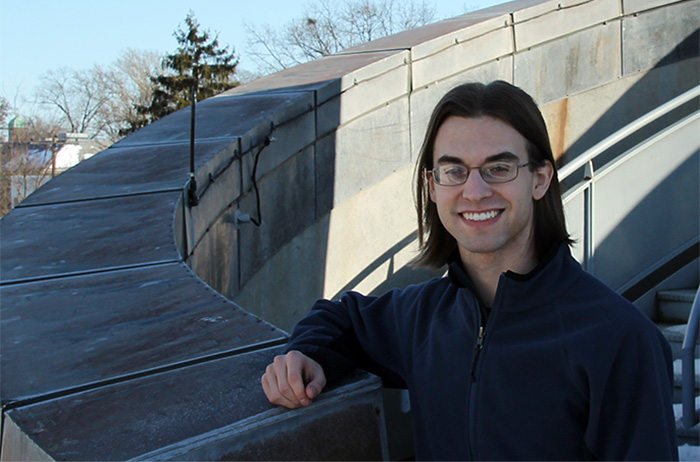Hitching His Wagon to a Star

Photo courtesy of Ben Kimock '15.
Ben Kimock ’15
Since coming to Dickinson, physics and math major Ben Kimock ’15 performed student-faculty research on a star system, worked on a solar air heater, held a product-development internship and took part in a National Science Foundation summer-research program. He also found an entirely new way to approach mathematics, much to his delight.
Majors:
Physics and Mathematics (astronomy minor).
Clubs and organizations:
Astronomy Club.
Honors/scholarships/awards:
Sigma Pi Sigma.
Favorite book:
Colors of Chaos by L.E. Modesitt Jr.
Favorite TV show:
Stargate Universe.
On choosing Dickinson:
I knew what I was going to major in, so my visits to college were very focused. I liked that when I visited the physics department here, everyone was friendly and talkative, instead of just trying to show off complicated research equipment.
Favorite place on campus:
Rector Atrium.
As a kid, I wanted to be …
… a paleontologist or astronomer.
On choosing my majors:
I
knew I wanted to major in physics before I came to Dickinson. I always did
quite well in the sciences and really enjoyed physics in high school. In
particular, I find physics work very rewarding because it (along with some
other fields) is a very creative venture. This may come as a surprise to some, but the
more advanced physics classes demand that the student be able to piece together
knowledge from previous courses in unfamiliar ways.
I picked up a major in math because of my experience in [Professor of Mathematics] Barry Tesman’s Calculus I course. Previously, I struggled in math (and I still do, compared to physics), but my view on math as a field totally changed when I was exposed to the college-level approach to the subject. In high school the math curriculum tries to force students through calculus as quickly as possible, so it glosses over the beautiful underpinnings of all the equations and techniques students are forced to memorize. The college curriculum slows down a little and has time to show the wacky tricks and strokes of genius that underpin all the dry equations of high-school math.
Little-known talents:
I’m very good at cooking, gardening and machining.
Favorite class:
COMP 314 - Theoretical Foundations of Computer Science. Many math and computer-science courses are about systems that are at least possibly a human creation (numbers, computers), but theoretical foundations introduces the study of what is universally computable. It turns out that there are many questions that are known to have no algorithm to find the answer. An example: Given any program and a description of what it is meant to do, can you tell me if it works?
About my research:
Analyzing archival data on the KH 15D binary star system [with Associate Professor of Physics & Astronomy Catrina Hamilton-Drager].
Post-Dickinson plans:
I have applied to Ph.D. programs in astronomy. I am interested in teaching physics and/or astronomy at the college level, but, based on my experience, I think I would go for any research position as well.
Biggest influence:
Neil deGrasse Tyson. Saying something quickly and in simple terms is often more valuable than saying it with great accuracy.
About my internships:
Research experience is very important in the sciences, so I wanted to get started as soon as possible. First, I interned in product-development research at Neatcap LLC, which designs hearing protection for premature infants. That internship got me into astronomy research. I also did a much more exciting research project at Lehigh University [through the National Science Foundation Research Experience for Undergraduates Program] that certainly wouldn’t have been possible without the first internship.
Learn more
- "Doing Physics" (video)
- “Observations and Calculations”
- “Hot Air Rising”
- “The Stars Look Very Different Today”
- More Student Snapshots
- Latest News
Published March 19, 2015